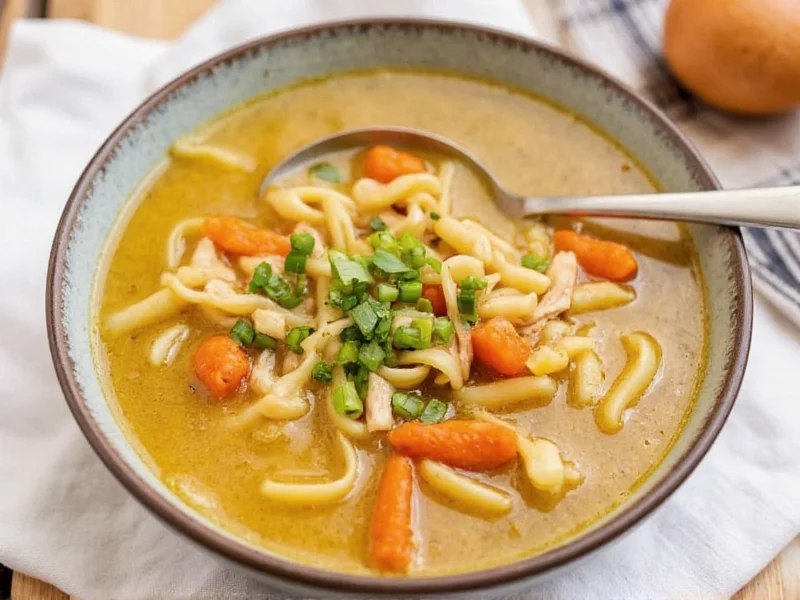Why Broth Quality Defines Exceptional Chicken Noodle Soup
Creating the best chicken noodle soup begins with understanding that broth quality is non-negotiable. Professional chefs and culinary experts agree that a deeply flavorful broth separates adequate soup from extraordinary soup. The magic happens through proper extraction of collagen and gelatin from chicken bones, which creates that signature rich mouthfeel and golden color.
For optimal results, use a combination of chicken backs, necks, and wings alongside your main chicken pieces. These bony parts contain abundant connective tissue that breaks down during slow simmering. The ideal simmering time ranges from 4 to 6 hours—any less and you won't extract sufficient flavor and body; any longer and the broth can become bitter.
Chicken Selection and Preparation Techniques
When crafting the best homemade chicken noodle soup, your chicken selection directly impacts the final product. Bone-in, skin-on chicken thighs provide superior flavor compared to breast meat alone, though a combination works best. The skin and bones contribute essential fats and minerals that enhance broth complexity.
Proper technique matters: brown chicken pieces in batches before adding to your broth for maximum flavor development through the Maillard reaction. Remove chicken when cooked through (about 25-30 minutes into simmering), then shred it while warm for perfect texture. Return the shredded meat near the end of cooking to prevent overcooking and stringiness.
Noodle Selection and Cooking Precision
The perfect noodle texture makes or breaks chicken noodle soup. Egg noodles remain the traditional choice for the best chicken noodle soup, but pasta shape and cooking method significantly affect the final dish. Wide egg noodles provide satisfying substance, while fine egg noodles create a more delicate soup.
Avoid the common mistake of cooking noodles directly in the soup for too long. For restaurant-quality results, cook noodles separately until just shy of al dente, then add to individual bowls before ladling hot broth over them. This prevents noodles from absorbing too much liquid and becoming mushy, especially important if you plan to store leftovers.
| Noodle Type | Best For | Cooking Time | Storage Tip |
|---|---|---|---|
| Wide Egg Noodles | Hearty, traditional soup | 6-8 minutes | Cook separately for storage |
| Extra Fine Noodles | Delicate, light broth | 4-5 minutes | Add just before serving |
| Rice Noodles | Gluten-free option | 3-4 minutes | Soak rather than boil |
| Whole Wheat Noodles | Nutritious variation | 7-9 minutes | Add later in cooking |
Vegetable Components and Timing
The classic mirepoix of carrots, celery, and onions forms the flavor foundation for authentic chicken noodle soup. For the best results, chop these vegetables uniformly (about 1/4 inch pieces) to ensure even cooking. Add them during the last 45 minutes of broth simmering to preserve their distinct flavors without becoming mushy.
Consider incorporating additional vegetables for complexity: parsnips add subtle sweetness, leeks provide mild onion flavor, and fresh dill or parsley added at the end brightens the entire dish. The timing of vegetable addition is crucial—harder vegetables go in earlier, while delicate herbs should be stirred in just before serving.
Seasoning and Flavor Balancing Secrets
Creating the perfect chicken noodle soup requires thoughtful seasoning at multiple stages. Begin with a generous amount of black pepper and a bay leaf during the broth simmering phase. Near the end of cooking, taste and adjust salt levels carefully—remember that saltiness concentrates as liquid evaporates.
The professional chef's secret for elevating homemade chicken noodle soup? A small splash of acid at the end. Whether it's fresh lemon juice, a dash of white wine vinegar, or a squeeze of lime, this final touch brightens all the flavors and creates a more complex, restaurant-quality soup. Fresh herbs like dill, parsley, or thyme added just before serving provide aromatic complexity that dried herbs cannot match.
Step-by-Step Preparation Framework
Follow this reliable method for consistently excellent chicken noodle soup:
- Prepare your broth base by simmering chicken bones with aromatics for 4-6 hours
- Remove and shred chicken, then strain and degrease the broth
- Sauté fresh vegetables in a bit of the reserved chicken fat
- Return broth to pot with vegetables and simmer until tender
- Cook noodles separately until just shy of al dente
- Combine shredded chicken, cooked noodles, and hot broth
- Add fresh herbs and a splash of acid just before serving
Avoiding Common Chicken Noodle Soup Mistakes
Even experienced cooks make these frequent errors when preparing chicken noodle soup:
- Boiling instead of simmering - Vigorous boiling makes broth cloudy and can create off-flavors
- Overcooking noodles in the soup - Leads to mushy texture and thickened, unappealing broth
- Adding all ingredients at once - Different components require different cooking times
- Skipping the skimming step - Failing to remove impurities during simmering affects clarity and taste
- Underseasoning - Broth needs more salt than you might expect for proper flavor balance
Storing and Reheating for Maximum Flavor
Proper storage techniques ensure your homemade chicken noodle soup maintains quality. Always store broth and noodles separately if possible—this prevents noodles from becoming waterlogged. When storing complete soup, slightly undercook the noodles to account for continued cooking during storage.
For best results when reheating, warm soup gently over medium-low heat without boiling. Add a splash of water or additional broth if the soup has thickened too much. Stir in fresh herbs after reheating to restore brightness. Properly stored, chicken noodle soup maintains peak flavor for 3-4 days in the refrigerator or up to 3 months when frozen.











 浙公网安备
33010002000092号
浙公网安备
33010002000092号 浙B2-20120091-4
浙B2-20120091-4